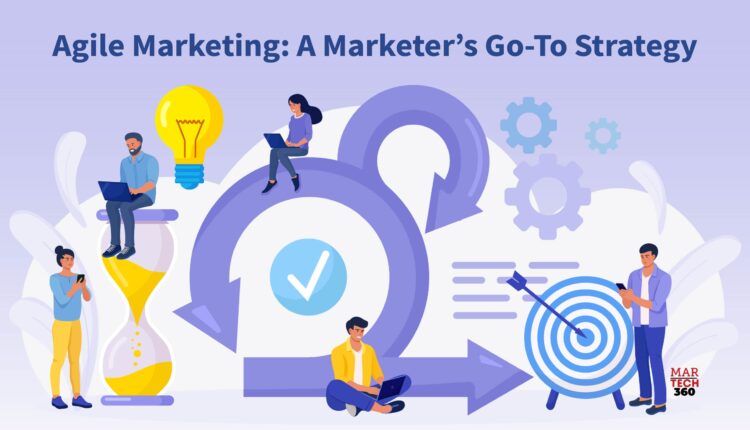Back in June 2012, 35 marketing enthusiasts gathered in San Francisco to craft the Agile Marketing Manifesto.
Now, that master plan is the North Star for a marketing strategy set to revolutionize your whole organization.
Agile marketing methodology is really taking off! According to AgileSherpas’ 2022 State of Agile Marketing Report, more than 40% of the 513 marketers they asked are already using some form of agile in their work. And, out of the 42% who are still sticking to traditional marketing methods, a whopping 91% are planning to switch to an agile framework within the next year.
Let’s take a dive into the world of this methodology in this comprehensive guide.
What is Agile Marketing?
Agile marketing is a form of marketing that makes use of agile methodologies. In short, it’s ideas and techniques. It is a marketing technique where teams come together to identify problems and invest their collective effort in high-profile tasks. Some common examples of this approach are self-organized, cross-functional teams that operate in periodic iterations with ongoing input. It also necessitates short-, medium-, and long-term marketing planning in addition to a strategic vision.
Depending on the organizational setting in which it is adopted, each methodology implementation has a slightly distinct appearance, but all of them share a number of essential traits. Agile teams continuously collect client information that can be used in real time. It works on some core values which are:
- Emphasizing more on customer value and organizational objectives instead of prioritizing activities and outputs
- It focuses on delivering value rather than sitting around and expecting to deliver perfection
- It highlights the need for learning through experiments and facts over outdated beliefs and systems.
- It further motivates cross-functional interaction instead of solely depending on hierarchies and silos.
How does Agile Marketing Work?
The approach thrives on frequent progress and adaptability. It combines careful planning with room for experimentation.
Prioritizing audiences is key, enabling precise targeting and swift reactions to emerging opportunities.
In Agile, teams may opt not to repeat a project if it doesn’t yield sufficient value. This can be a strategic win, allowing resources to be redirected.
Failures serve as learning experiences, informing future endeavors for even better outcomes. The core values of this method are:
- Embracing change over rigid plans.
- Opting for rapid iterations instead of extensive campaigns.
- Relying on testing and data rather than assumptions and unwritten rules.
- Conducting numerous smaller tests rather than placing all bets on a few big initiatives.
- Valuing individual contributions and interactions over broad market strategies.
- Prioritizing collaboration over silos and hierarchical structures.
Also Read: Mobile Miracles: Creating Seamless Customer Journeys
What are the Benefits of Agile Marketing?
 Agile marketing teams who approach their work with a well-defined plan are capable of executing tasks swiftly and purposefully. A survey conducted in 2017 revealed that 94 percent of companies consider agility and collaboration crucial for their achievements, while 32 percent have already initiated efforts to enhance their agility.
Agile marketing teams who approach their work with a well-defined plan are capable of executing tasks swiftly and purposefully. A survey conducted in 2017 revealed that 94 percent of companies consider agility and collaboration crucial for their achievements, while 32 percent have already initiated efforts to enhance their agility.
Key benefits of this approach include:
- Unified marketing efforts: Aligns digital, content, and product marketing for a seamless customer experience.
- Cost efficiency: Avoids wasteful investments by quickly adapting to audience preferences.
- Data-informed choices: Real-time metrics guide adjustments for better customer reach and engagement.
- Enhanced collaboration: Promotes efficient resource utilization and balanced workloads across teams.
What are the Three Primary Principles of Agile Marketing?
 Currently, the method is employed by 41% of organizations, and an additional 42% have intentions to adopt it within the coming year.
Currently, the method is employed by 41% of organizations, and an additional 42% have intentions to adopt it within the coming year.
The three primary principles of this methodology are:
1. Customer satisfaction
Agile marketing places emphasis on providing value and meeting the demands of customers. It prioritizes gaining insights into customer preferences, collecting feedback, and adjusting marketing approaches accordingly.
2. Responding to change
It acknowledges the inevitability of change and adopts a flexible mindset. It understands that marketing needs and priorities can swiftly alter, highlighting the importance of promptly adapting and modifying marketing approaches and tactics.
3. Collaboration
It facilitates cooperation and teamwork amongst cross-functional teams, stakeholders, and various departments in an organization. This partnership is instrumental in nurturing creativity, fostering innovation, and facilitating efficient decision-making processes.
These principles guide agile marketing teams in their approach to planning, executing, and evaluating marketing campaigns.
Why is Agile Marketing A Marketer’s Go-To Strategy?
Its core values are a major contributing factor for more and more marketers going ahead to adopt advanced marketing techniques. It allows marketers to have the necessary data, analytics, and marketing technology infrastructure in place as well as a clear understanding of what they want to achieve with their agile initiatives. For example, it helps in deciding which customer segments it wants to acquire or which customer decision journeys need improvement.
It is quite a technological boom that enables marketers to gather, organize, and manage data from multiple systems; base decisions on sophisticated predispositions and next-best-action models; to automate the allocation of campaigns and messages across channels.
Campaigns for this method are fundamentally different from those used for traditional marketing. Agile teams are capable of moving faster and it completely rules out the demanding and lengthy market research operations.
It can be steadily embraced by businesses if they commit to implementing an agile mentality throughout the entire organization. Department heads, directors, and project managers will, nevertheless, become more aware of the benefits of agility as traditional marketing shifts towards agility.
Final Thoughts
Embracing the agile marketing methodology is a game-changer for modern marketers. It’s not just a buzzword; it’s a transformative approach that empowers teams to adapt, innovate, and deliver results in today’s dynamic landscape. With the right agile marketing software in place, teams can streamline workflows, collaborate seamlessly, and make data-driven decisions with ease.
By prioritizing customer-centricity, quick iterations, and cross-team collaboration, the approach opens the door to unparalleled efficiency and effectiveness. It’s the go-to strategy that keeps you ahead of the curve in a rapidly evolving marketing landscape.


Comments are closed.